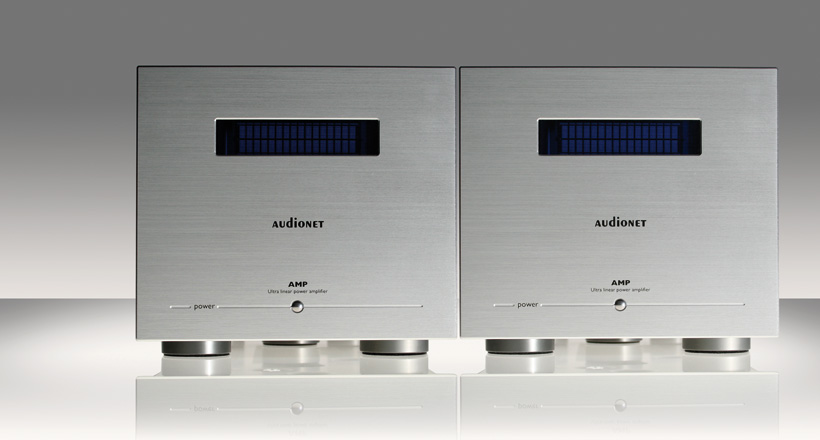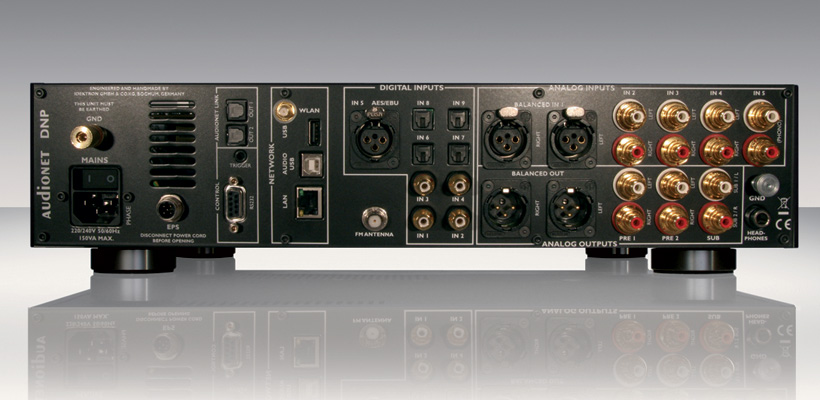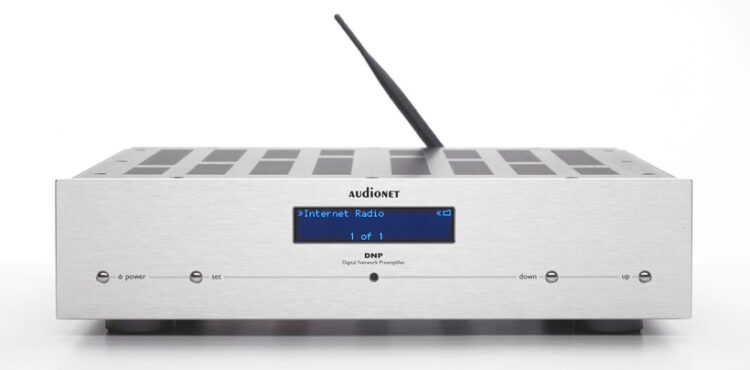When it comes to well designed and well-built German audio equipment there are many companies that deliver the goods but a list of names would never be complete, so I won’ try. I will make one exception however, Audionet, a company that makes a range of electronics including the DNP, a single box that does virtually everything except make tea, and compact, heavy, monoblock power amplifiers simply called AMP.
The sleek appearance of the DNP doesn’t shout about the features that are built into it but the wi-fi aerial gives you a clue about one of them. This is a high end preamplifier with a digital to analogue converter, an analogue to digital converter, a network player, phono preamp, headphone amplifier, FM tuner and finally also a room correction system/equalizer. To operate the device there are four buttons on the faceplate (labelled power, set, up and down) together with an App for iOS or Android, alternatively Audionet supplies software that runs on a Windows PC. Some of the settings are displayed on the easily read display. The back panel is as busy as the front is simple. It has a power connection with an additional earth point next to a socket for an external power supply (which was not available at the time of this review). There are triggers for 12 Volt and Audionet’s optical LINK bus. This is to switch other Audionet devices on and off, but not all at once, the mono amplifiers are switched on one after the other. Next are the network connections for Ethernet and WLAN. USB-A and -B sockets can be used for USB sticks or for a computer with music files and there is no shortage of digital inputs. There are eight S/PDIF inlets, four Toslink and four for RCA plus a single XLR for AES/EBU. An F-connector is available for FM.
So much for digital. For analogue there are also four RCA inputs, the fourth can be used with an optional phono module. You can also use a balanced XLR input but be aware that the DNP is internally unbalanced. Outputs consist of two RCA, one XLR, a headphone jack and two (switchable into mono) outputs for a pair of subwoofers. The AMP power amplifiers look rather simple in comparison with their single RCA and XLR inputs, Audionet LINK buses and dual speaker terminals. The internal signal circuit inside the power amplifiers is unbalanced, so you should connect them to the DNP with RCA terminated single ended cables. On each AMP we find a display that shows some useful information. For the record: all aluminium faceplates are available in silver or black, all displays in blue or red.

Under the hood
Under the DNP’s hood there lurks a stack of electronics, I was struck by the amount of LEDs in the circuits, they set the amplifier aglow. Audionet prides itself on its extremely pure power supply and in-house developed voltage regulators. Instead of zenerdiodes Audionet uses red LEDs because they have superior characteristics, apparently red LEDs produce less thermal noise than other colours. There is an art to making a good preamp with a lot of features but that trick is not uncommon, what is unusual in the DNP is the extensive options for EQ or room correction. By using Audionet’s software you can adjust output at different frequencies, the steepness of the filters and their Q. Twenty independent correction curves can be linked to each input. You can have a curve that’s made not only for room correction but for old records too, old CDs from the eighties, tape recordings, etc. The correction takes place entirely in the digital domain and, if necessary, analogue signals are converted by the onboard ADC. The word depth in the digital domain is 48-bits, so the signal is not audibly affected. As a service the Audionet dealer can measure the listening room for you with Carma software, the resulting curve can then be uploaded to and stored in the DNP. Use the room correction only to suppress annoying standing waves or room resonances, don’t try to fill gaps because that does more harm than good. Of course a purist will say room correction affects the music signal. True, but what would you prefer? A flattened response and multi note bass or sore ears every night thanks to the standing waves in your room?
You don’t have to use it of course. With the digital filtering it is also possible to control one or two subwoofers. With the DNP those woofers and amplifiers can be passive because the crossover frequency, filter slope and delay are adjustable within the DNP. Is it difficult to set up? No, using the Audionet software is a piece of cake. With all these options on the DNP there’s a danger of overlooking the effort Audionet has put into the amplifiers. What does one make of the many separate power circuits in both the DNP and the AMP? For example in the final stage there are separate power supplies for the first stage and the output transistors.

Proving the pudding
Nice electronics are no proof that a devices will sound good of course. To find out I put them into my system which consists of a NAD M50/M52 network player in combination with an Esoteric D-07 DAC for digitally stored music. A Transrotor turntable with SME arm, Transfiguration cartridge and tube phono stage for my vinyl collection. A Magnum Dynalab tuner is also in use for FM radio. The network player, DAC and tuner are obviously not necessary with the DNP, but fun to compare. A nice pair of PMC fact.8 speakers were connected to the AMPs. Everything was wired single ended with Crystal Cable and the amplifiers weren’t connected to my line filters but fed directly from a clean power outlet. The listening room is acoustically tuned with damping material on the back of some paintings and six Acoustic System resonators, not to mention a thick rug on the wooden floor. Not much more is necessary for a reasonably balanced acoustic without annoying peaks and gaps in the frequency response. Unfortunately I wasn’t able to measure the room with the Carma software but I was able to arrive at a useful curve that I tweaked by ear for optimal results.
Finally I could listen! From the first notes one thing was immediately clear: the massive grip of the power amplifier over the speakers. It was almost unbelievable how tight the bass was compared with other amplifiers that I have been using recently. It’s a grip that allows listening at low volumes, but remains consistent when turning it up. A track like Avratz by Infected Mushroom hammered through space. On Siri's Svale Band’s Blackbird the bass quickly becomes exaggerated, the Audionet AMP does not reduce the amount of energy in the bass, but it’s tight and has great definition. You might get the impression that the frequency response is limited in the lower part of the curve, however the opposite is true. The AMPs pull the bass a few steps further down to just a few Hertz with amazing flexibility and force. I am an avid supporter of the principle that proper bass is a necessary foundation on which to build the mid tones and treble. The Audionets proved my point when I played Eliane Elias. Her piano sounds very smooth and her warm voice becomes alive so that it crawls under the listener’s skin. Your attention is soon drawn into the music and everything else takes second place, this is one of the things that distinguishes a great audio system. It creates the illusion that the lady in question is tempting you and only you, her slightly husky voice making her more attractive and sexy. Should she hit the keys of the piano hard the Audionets have almost limitless power reserves with which to deliver the impact. So at higher volumes the sound does not close in and nor harden. Meanwhile Eliane plays and creates a perfect picture. Rather than looking for something else to play I left my iPad on the table, always a good sign.
I watched the TV series 'Homeland' with the Audionet amplifiers in the system and noticed a constant, growling low bass tone in the sound track that had not been apparent before. This tone is crucial to the atmosphere of the show. The Audionets and my PMC speakers made the entire hour more atmospheric, producing an adrenalin high that you rarely get with TV.
When the Elias CD had finished the Combattimento Consort Amsterdam came onstage playing the Concerti Grossi by Handel. This great piece of music and Audionet seemed to be made for each other. Streaming from my Synology NAS as ripped FLAC files, flawless and pure with no trace of exaggeration in the violins, no mess in the bass, no closing-in of midrange. The sound is completely balanced, wherein each frequency gets the right amount of attention. My PMCs are definitely not forgiving speakers and highlight any shortcomings in the electronics. With these amplifiers nothing is illuminated because there are no nasties to hear. Long sustained tones fade away until they disappear into the distance, into the background noise every city apartment has. When the orchestra plays loud, the power amplifier runs along smoothly. Of high-quality power you can never have enough in my opinion, one of the reasons my 300B period is very far in the past. Even though I don’t play extremely loud and have been on good terms with the neighbours for over two decades, the power of 200 watts at 8 ohms (up to 750 watts into 1 Ohm) per monoblock is something that you ‘experience’. I also notice the power reserve when I turn to a solo piano piece by Martha Argerich, Musique de Chambre by Schumann. Her grey hair isn’t as luxuriant as it once was but her touch is just as sparkling as in her youth. It is hard to describe what turns the piano into a real instrument and what not. The fact is that the Audionet’s come very close to how I remember a piano sounds in real life. After thirteen pieces Scènes d'enfants the public suddenly claps, it scares me for a moment because I was so absorbed in the music. Not for a second was I aware that it was a recording of a live concert. To recover I end a morning of listening with Riders on the Storm by The Doors. A nice contrast to Argerich and with a network player like the DNP it takes just a few swipes of a touchscreen to alter the atmosphere.

With enough stuff at home making a comparison between various solutions is fairly straightforward. With a sound pressure meter and a test tone I levelled the inputs. This is a very precise job, because a half decibel more or less affects the outcome of the comparison. A dash more volume gives one device an unfair advantage. The Audionet software is a blessing to use in such comparisons with half a decibel accuracy of control over each input. So I made the internal streaming exactly equal to the S/PDIF coaxial input from a NAD M50/M52 combination and I fed that same signal to a D/A converter from Esoteric that was connected with balanced cables to the Audionet DNP. FLAC files from the M52 storage unit are bit by bit identical to the FLAC files I pull from my NAS with the DNP. The result of the comparison is exceptional for the DNP, remarkable, because the combination of NAD and Esoteric costs as much as an entire DNP! But the NAD player wins points over the integrated Audionet, the latter has slightly higher resolution but the NAD sounds closer to a pure analogue source. The difference between the two network players is much smaller than I expected. In previous reviews of network players the NAD was far, far into the lead, the Audionet comes a close second place and both put other network players in the shade. The NAD with an Esoteric D/A converter feeding the DNP and AMP raises the results even further. This mainly manifests in a larger stereo image, friendlier sound and more relaxed listening. Image height is better with the Audionet DAC, but width and depth are better with the Esoteric DAC. Because the Esoteric places every instrument in a more airy environment they are easier to follow individually. However, we need to pay extra attention to the beautiful integration of network player, DAC and preamplifier in the Audionet DNP. Any consumer considering Audionet should only need to decide whether he or she wants to invest in a network player and DAC with a preamp, or have the convenience of the single box DNP. The choice is more about taste than sound quality. I prefer a more laid back performance to the highly detailed, clear sounding DNP. Take a look at the advantage in price achieved with the DNP, the huge range of options offered and the ease of operation with just an App or the RCP software, and things look rather favourable for the Audionet. Unless you are one of a select group of audiophiles who really want the best of the best, with all the inconveniences that comes with it
Conclusion
Audionet has established a good reputation in a number of countries and this is not surprising given the quality of the products. The vast amount of inputs and outputs, the many options and the completeness of the AMP and DNP need no further comment. In a nutshell this combination with its clean sound, high level of resolution, excellent stereo image and super tight control over the speakers makes listening very pleasant. All I wanted was a little more ‘colour’, it is so neutral that I actually longed for less detail in exchange for a little more emotion. This is a matter of taste of course and not everyone shares mine. Audionet is pure, honest and tight; three very good reasons for buying the DNP and AMP. That the AMP power amplifiers have a distinct influence on the overall result should be clear. If you are after maximum control they should be at the top of your list.
Note: This review was originally published in the Dutch magazine Music Emotion


